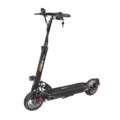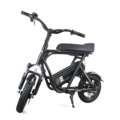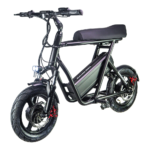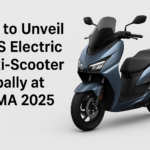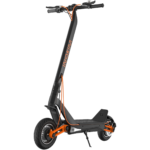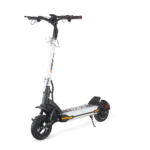- Home
- Scooters
- Electric Scooters
- EMOVE RoadRunner Pro
EMOVE RoadRunner Pro
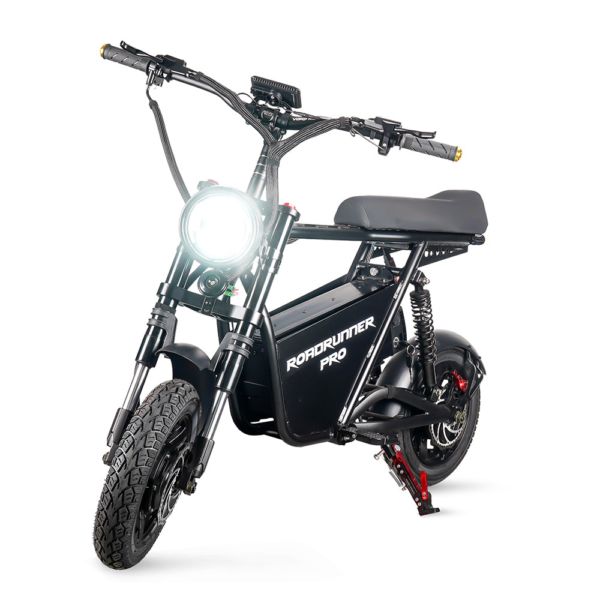

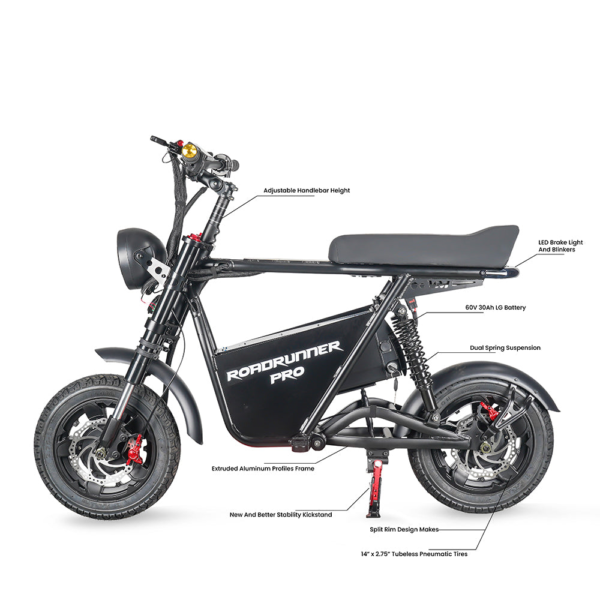
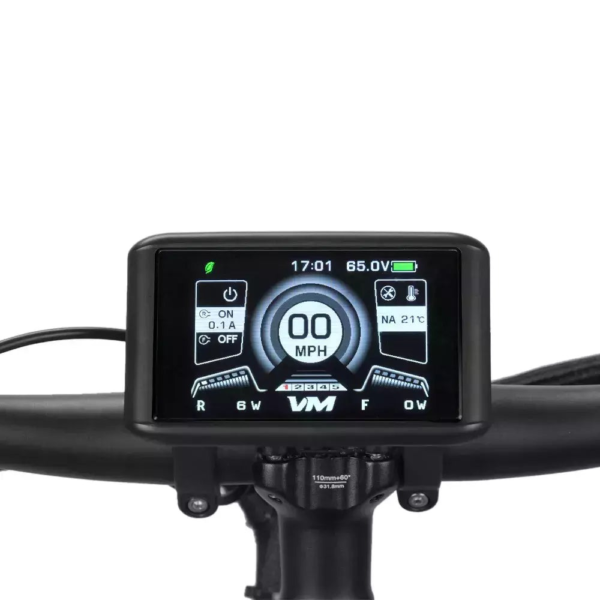
- Battery Range: 50 miles (80 km)
- Top Speed: 50 mph (80 km/h)
- Motor Power: Dual 2000W
- Weight Capacity: 330 lb (149.7 kg)
- Charging Time: 9 hours
- Scooter Weight: 114.4 lb (51.9 kg)
PROS
- 50 mph (80 km/h) top speed
- 60V 30Ah LG battery (1,800 Wh)
- Full suspension front & rear
- Hydraulic 2-piston Zoom brakes
- 14″ tubeless pneumatic tires
CONS
- Very heavy to carry
- No official IP rating
- Expensive vs entry-level options
Key Takeaways
- The EMOVE RoadRunner Pro is a compact seated electric scooter designed for stability and comfort on city rides.
- It features a 60-volt battery, dual hub motors, and a comfortable long saddle for extended use.
- Key specifications include a top speed of up to 45 mph, a claimed range of 50 miles, and a max rider weight of 330 lbs.
- The scooter’s build includes hydraulic disc brakes, a robust alloy frame, and a suspension system for smooth rides.
- It’s ideal for commuters and larger riders but may not suit those needing a lightweight, easily portable option.
Table of contents
- What Is the EMOVE RoadRunner Pro?
- How the EMOVE RoadRunner Pro Works
- Key Specifications
- Design & Build Quality
- Performance Fundamentals
- Battery, Range & Efficiency
- Ride Quality & Comfort
- Braking & Safety Features
- Portability & Daily Usability
- Maintenance & Care
- Weather & Seasonal Considerations
- EMOVE RoadRunner Pro vs Alternatives
- Who the EMOVE RoadRunner Pro Is (and Isn’t) For
- FAQs
- Glossary
The EMOVE RoadRunner Pro is a compact, seated scooter built for fast city miles. It mixes mini-bike stability with simple scooter controls. So you get speed, range, and a calm ride in one package. And yes, it feels easy to live with day after day.
What Is the EMOVE RoadRunner Pro?
The EMOVE RoadRunner Pro is a seated electric scooter with two hub motors and a 60-volt battery. It looks like a tiny moto, yet it rides like a scooter you already know. You sit low, grab a wide handlebar, and roll on big 14-inch pneumatic tires. So the chassis stays steady at speed. And the long, cushioned saddle supports longer trips without sore wrists or knees.
It targets riders who want more stability than a stand-up commuter but less bulk than a full e-moto. So you get real road pace, stronger brakes, and a planted stance on patched streets. Then you arrive fresh, since your arms do not carry your weight the whole time. Plus, upkeep stays simple with quick checks and basic tools. If you want lighter siblings in the same family, take a look at the EMOVE RoadRunner V2 and the EMOVE RoadRunner SE.
How the EMOVE RoadRunner Pro Works
Most e-scooters share the same core systems. This one upgrades the parts that matter and keeps the rest straightforward.
Motor and controller. Two hub motors sit in the wheels. So the pull feels even, and traction stays balanced. Sine-wave controllers feed power with a smooth ramp. Then the throttle stays calm at low speed and firm as you roll on. And cruise feels stable on flat roads.
Battery. A 60 V pack sits under the seat. It uses 21700 cells and stores about 1.8 kWh of energy. So you can ride far on one charge when you keep a steady pace. On most trims the pack lifts out, which helps with indoor charging and storage.
Throttle. A thumb or trigger unit (trim dependent) sends a signal to the controller. Then phase current flows to the motors. The sine-wave drive cuts cogging and keeps noise low. So launches feel natural, and mid-speed roll-on remains easy in traffic.
Brakes. Dual hydraulic discs handle stops. Lever throw is short, and bite builds in a smooth curve. So panic stops feel straight when you shift your weight back. And the 14-inch wheels add leverage for steady decel.
Suspension. A hydraulic fork up front and twin shocks at the rear manage bumps. Spring and damping are set for street speed and mixed pavement. So the frame stays composed over cracks, brick, and rail seams.
Key Specifications
These are the official core specs for the EMOVE RoadRunner Pro. Real-world results will vary with rider weight, terrain, wind, and tire pressure.
General
| Item | Value |
|---|---|
| Model | EMOVE RoadRunner Pro |
| Vehicle type | Seated electric scooter (mini-bike form) |
| Intended use | Urban commuting and longer city rides |
| Max rider weight | 330 lb (150 kg) |
| Frame material | Alloy frame with integrated seat base |
| Tire size/type | 14 × 2.75 in pneumatic (tube) front and rear |
Performance & Power
| Item | Value |
|---|---|
| Motors | Dual hub motors, front + rear |
| Controller type | Dual sine-wave |
| Nominal system voltage | 60 V |
| Peak speed (rated) | Up to 45 mph (72 km/h) |
| Hill grade | ~10% short climbs with momentum; ~7% sustained at moderate speed |
| Drive modes | Multi-level speed modes with user P-settings |
| Cruise control | Yes (toggle in settings) |
Battery, Charging & Electrical
| Item | Value |
|---|---|
| Battery capacity | ~1,800 Wh (60 V, 30 Ah) |
| Cell format | 21700 high-capacity cells |
| Battery design | Under-seat pack, removable on most trims |
| Claimed range | Up to 50 miles (80 km) at lower speeds on flat routes |
| Charger | 60 V standard charger, ~3 A |
| Charge time (0–100%) | ~10–12 hours with standard charger |
| Fast-charge support | Yes, with compatible high-current charger |
| Lighting | LED headlight; taillight with brake light; turn signals |
| Display | Central display with speed, mode, battery, trip data |
Build & Dimensions
| Item | Value |
|---|---|
| Wheelbase | Long, mini-bike stance for stability |
| Handlebar width | ~25.5 in (65 cm) |
| Seat height | ~28–31 in adjustable (71–79 cm) |
| Vehicle weight | ~114 lb (52 kg) |
| Overall L × W × H | ~55.5 × 25.5 × 42 in (141 × 65 × 107 cm) |
| Folded dimensions* | ~55.5 × 14 × 30 in (141 × 36 × 76 cm) with bar folded |
| *Note | Handlebars fold; chassis does not fold |
Safety & Control
| Item | Value |
|---|---|
| Brakes | Dual hydraulic disc brakes |
| Rotors | Street-size rotors with strong bite |
| Traction | 14-inch pneumatic tires |
| Water resistance | IPX6 splash resistance |
| Horn | Electronic horn |
| Side stand | Yes |
Features & Extras
| Item | Value |
|---|---|
| Cruise Control | Yes |
| Seat | Thick, long saddle with room to shift |
| Battery access | Seat lifts for battery access on removable-pack trims |
| Controls | Mode selector, turn signals, lights, horn |
| Security | Keyed power or switch logic; add a physical lock for parking |
| Carry points | Rear grab points |
Warranty & Compliance
| Item | Value |
|---|---|
| Warranty | 12 months limited on core components; wear items excluded |
| Compliance | IPX6 water resistance; follow local rules |
Design & Build Quality
Pick the scooter off its stand, and the frame feels stout. The welds look clean, and the seat base resists flex. So you sit “in” the scooter rather than “on” it. Then your center of gravity stays low, and the bike tracks straight at speed.
Move to the cockpit, and the layout makes sense. The wide bar keeps steering light. Grips feel soft yet secure. And the levers sit at an easy reach. The display stays bright in daylight, which helps when you glance down at a stop. So the numbers remain readable at noon. Plus, the switches click with a positive feel, which helps with gloves.
Down at your feet, the platform under the seat gives room to move. Slide forward for quick turns. Then slide back for cruise comfort. The long saddle lets taller riders stretch out. And shorter riders still reach the ground with ease at lights.
Fit and finish support daily use. Cables run clean lines. The side stand swings out with a stable foot. And the fenders block spray well across the wheel arc. So grit and water stay off your legs when the road turns wet. For night rides, the lights help you stand out. The headlight throws a wide beam. And the brake light snaps bright when you squeeze the lever.
Performance Fundamentals
Twist the throttle, and the scooter launches with calm force. The two motors share the work. So the front stays planted, and the rear hooks up. As speed builds, the sine-wave controllers keep the pull smooth. Then mid-range thrust carries you through gaps in traffic.
From a walking start, the surge feels brisk yet controlled. So tight spaces stay easy to handle. On open roads, roll the throttle, and the Pro answers. Passing pace arrives fast on city avenues. And the long wheelbase holds a straight line as you accelerate.
On hills, the scooter keeps pace better than stand-up commuters in this weight range. Short ramps near 10% feel easy with a run-up. Sustained grades near 7% hold a steady climb at moderate speed. So you can crest neighborhood rises without drama. On hot days, give the system a short rest at the top after long pulls.
Stability stands out at cruise. The fork and shocks mute small chatter. So your hands can relax, and the chassis soaks up cracks. The large wheels roll through small potholes that stall tiny scooters. Then, at higher pace, the bike still feels planted on smooth pavement. Wear a full-face helmet and armored gloves when you ride near top speed.
Battery, Range & Efficiency
The 60 V, 30 Ah pack stores about 1,800 Wh. So you have real energy for full days in the city. Range depends on pace, weight, wind, slope, and pressure. And temperature moves the needle more than most expect.
At a steady cruise in the mid-teens mph on flat streets, many riders see 40–50 miles (64–80 km) per charge. In mixed traffic with stops, expect less. At top speeds, expect a steep drop. So plan your route with a buffer for detours and weather.
Charging stays simple. The stock 3 A charger fills the pack in about 10–12 hours. A higher-current unit can shorten that window when supported. Charge on a stable surface at room temp. And keep daily use between roughly 20% and 80% when you do not need maximum range. Then save full charges for longer rides.
Cold cuts range. So expect fewer miles below 40 °F (4 °C). Heat stresses cells and controllers. So park in the shade, and let the pack cool after hard runs before a full charge. Tire pressure matters too. Keep a gauge near your charger. Then set pressures to match the day’s plan.
Ride Quality & Comfort
Comfort is the point of a seated scooter, and this one nails it. The 14-inch pneumatic tires add a cushion of air. So cracks, seams, and brick feel muted. The fork is set for street use. It trims sharp hits and keeps steering precise. Then the rear shocks add support without kickback.
Ergonomics fit a wide range of riders. Slide forward for tighter turns. Then slide back for relaxed cruising. The wide bar adds leverage at low speed. So U-turns and narrow garage exits feel under control.
Stem flex stays low thanks to the short steering column and stout frame. So the front end resists head shake over bumps. Keep both hands on the bar on rough streets. And keep your elbows soft to help the fork do its job.
Tire pressure tunes the ride. Start around 35–40 psi (2.4–2.8 bar) for average weight. Then move down a touch for grip and comfort. Or move up for speed and range. Check weekly. And inspect the sidewalls before long rides.
Braking & Safety Features
Hydraulic discs give this scooter confident stops. Lever throw is short, and pad bite grows in a smooth curve. So one or two fingers deliver strong decel. Modulation feels easy on wet pavement.
Practice body position. Sit back and drop your heels as you brake hard. The long wheelbase resists rear lift, yet your posture still matters. On wet days, scrub speed early. Then keep the bike upright through turns. And avoid paint lines, plates, and leaves when you can.
The light set supports real traffic speeds. Run the headlight in daylight for visibility. Add a reflective strap on your bag at night. For city rides, a helmet-mounted light helps you aim into turns. Then drivers at cross streets can see you as you look toward them.
Water resistance is IPX6. So the scooter handles puddles and light rain. Avoid deep water. And avoid charging while the pack is warm and wet. Wipe the bike dry after each wet ride. Then add a light protectant to exposed fasteners.
Portability & Daily Usability
This scooter is not a featherweight. At about 114 lb (52 kg), it is best rolled, not carried. The side stand is sturdy. So quick stops at shops stay simple. The handlebar folds down for car transport or tight storage. Then the footprint shrinks for hallways and sheds.
On removable-pack trims, the seat lifts for access. So you can bring the battery indoors. That helps in cold winters and in shared garages. And it simplifies storage at a mid-state of charge.
Security needs a plan. Use a heavy U-lock or a chain through the frame. Then add a cable through the wheels for longer stops. A small alarm or a hidden tracker under the seat adds peace of mind. Park under cameras when you can.
Daily habits keep ownership easy. Keep a small pump and a multi-tool near your charger. Check tire pressure twice a week. Look over the pads once a month. And wipe grit off the fork stanchions after wet rides to protect the seals.
Maintenance & Care
Good habits keep the RoadRunner Pro tight and quiet.
- Tires. Check pressure weekly. Inspect tread and sidewalls. Replace tubes at the first sign of pinch flats or valve stem cracks. Then re-seat beads with care.
- Brakes. Test lever feel before each ride. Pads should not rub as the wheel spins. Top up mineral oil only after you confirm no leaks. Then bleed with the correct kit when needed.
- Fasteners. Do a five-minute bolt check every two weeks. Focus on the bar clamp, brake calipers, rotor bolts, axle nuts, and fender mounts. Use thread locker where the maker calls for it.
- Driveline. Keep motor cable strain reliefs seated. Inspect connectors after heavy rain. Then dry fully before charging.
- Battery and charging. Charge on a stable surface at room temp. Start rides near 90% for routine days. Save 100% for long trips. Store at 40–60% if you pause riding for more than a month.
- Settings. If your trim offers P-settings, record the stock values. Then change one item at a time and test in a safe lot.
- Cleaning. Use a damp cloth and mild soap. Avoid pressure washers. Keep water away from the charge port and display seams.
A simple schedule helps:
- Every ride: Quick visual check, tire pressure glance, lever feel.
- Weekly: Gauge pressures, wipe dust, check lights and horn.
- Monthly: Pad wear check, rotor rub check, bolt check, cable inspection.
- Quarterly: Bleed brakes if needed, refresh tubes if worn, inspect bearings.
Weather & Seasonal Considerations
Rain, heat, and cold all change how the scooter feels. So adjust your plan for the day.
Wet days. Lower speed and add space. Paint, plates, and leaves cut grip. So brake earlier and stay upright through turns. Keep lights on in daylight for visibility. Then dry the bike after each ride.
Cold days. Range drops with temp. So plan shorter legs. Inflate tires toward the lower end of your band for grip. Warm the battery indoors before charging. Then ride with smooth inputs to avoid front-wheel spin on frost.
Hot days. Heat stresses cells and controllers. So park in the shade. Give the scooter short rests after long high-speed runs. Then charge in a cool room to protect the pack.
Storage. If you pause for winter, charge to about 50%. Remove the pack if your trim allows it. Then store at room temp in a dry place. Top up monthly to keep cell balance.
EMOVE RoadRunner Pro vs Alternatives
This scooter sits between stand-up commuters and true e-motos. So it covers a wide set of use cases.
- Against compact commuters. The Pro rides more stable at speed, stops shorter, and goes farther. And the seat saves your legs on long routes. But it weighs a lot more and takes more space at home.
- Against performance stand-ups. The Pro gives similar thrust with a lower center of gravity. So rough streets feel calmer. But it lacks the grab-and-go carry ease of a 60–70 lb deck scooter.
- Against off-road models. The Pro is meant for streets and light paths. It climbs well and handles broken pavement. But it is not a trail bike, and it does not aim for jumps or loose dirt.
- Against mini e-motos. The Pro is simpler, lighter, and easier to store. It is street-quick up to city limits. But a true e-moto still offers higher top speed, larger brakes, and longer travel.
Paper specifications tell part of the story. On the road, the low seat, wide bar, and big wheels add up to calm control. So the RoadRunner Pro makes daily miles feel easy even when traffic flows fast.
Who the EMOVE RoadRunner Pro Is (and Isn’t) For
Great for:
- Riders who want seated comfort with scooter controls.
- Commuters who value range, large wheels, and strong brakes.
- Students who cross town at steady pace.
- Multi-modal travelers who roll to rail and continue on bike lanes.
- Bigger riders who need high load capacity and a sturdy frame.
Not so great for:
- Walk-up apartment dwellers who must carry a scooter upstairs.
- Riders who want a light, fold-and-go deck scooter.
- Trail riders who want knobby tires and long travel.
- Shoppers with tight hallway storage where width is limited.
FAQs
1) How fast is the EMOVE RoadRunner Pro?
On a clear, flat road, the Pro can reach the mid-40s mph range. So ride within local limits and wear full safety gear.
2) What range can I expect per charge?
At steady city pace on flat routes, many riders see 40–50 miles (64–80 km). In strong wind, on hills, or at high speeds, expect less.
3) Does the battery come out?
On most trims, yes. The under-seat pack lifts out. So you can charge indoors or store the pack at a mid-state of charge.
4) Can it climb hills?
Yes. Short ramps near 10% feel easy with a run-up. Sustained grades near 7% hold a steady climb at moderate speed.
5) What tire pressure should I run?
Start around 35–40 psi (2.4–2.8 bar). Then tune for weight, comfort, grip, and range. Recheck weekly for best results.
6) Is it water resistant?
The rating is IPX6. So it handles light rain and puddles. Avoid deep water and pressure washing, and dry it after wet rides.
7) Where can I find an “EMOVE RoadRunner Pro overview”?
You are reading it. This guide covers design, power, range, care, setup, and key specifications in one place.
Glossary
- Ah (Amp-hours): Battery capacity. Higher Ah means more stored charge.
- Wh (Watt-hours): Total energy. Multiply voltage by amp-hours.
- Controller: The unit that feeds power from the battery to the motors.
- Sine-wave: Control style known for smooth, quiet motor behavior.
- Regen: Electronic braking that can feed a small amount of energy back.
- Preload: A spring setting that changes ride height and initial firmness.
- Damping: Control of spring motion as it compresses and rebounds.
- Stem flex: Bending in the steering column that reduces precision.
- IP rating: Water-ingress rating. IPX6 resists high-pressure spray.
- P-settings: User options that adjust speed modes and features.
- Peak speed: The highest speed possible in ideal conditions.
- Torque: Rotational force that drives acceleration.
- Rotors: Steel discs the brake calipers clamp to slow the wheels.
- PSI / Bar: Tire pressure units. 1 bar is about 14.5 psi.
- SOC (State of Charge): Remaining battery percentage.
Specifications
General
| Model The Model specifies the exact version or name of the scooter. It helps identify its unique design, features, and specifications within the manufacturer’s product line. Knowing the model makes it easier to compare options, find compatible accessories, or look up support information. | RoadRunner Pro |
| Brand The Brand identifies the manufacturer or company that designs and produces the scooter. A trusted brand is a sign of quality, reliability, and good customer support. Well-known brands often have higher standards for safety, performance, and after-sales service, giving you more confidence in your purchase. | EMOVE |
| Release Date The Release Date indicates when the scooter model was officially launched on the market. This helps you know how current the design, technology, and features are. A newer release date often means updated components, improved performance, and the latest safety or smart features. | 18 November 2025 |
| Recommended Age Recommended Age indicates the minimum age range that the scooter is designed for, based on safety, size, and ease of use. Following the recommended age helps ensure that riders can handle the scooter’s speed, weight, and controls comfortably and safely. Always check local laws and use protective gear, especially for younger riders. | +16 |
Performance & Power
| Motor Power (Wattage) What it means: The motor power, measured in watts (W), shows how strong the scooter’s electric motor is. Why it matters: Higher wattage usually means better acceleration, more torque, and improved performance on hills or rough terrain. For example, a 250W motor is good for flat city roads and light riders, while a 500W or 1000W motor provides more power for faster speeds or climbing steep inclines. | Dual 2000W hub motors (continuous) |
| Top Speed The Top Speed indicates the maximum speed that the scooter can reach under optimal conditions. It’s usually measured on level ground with a fully charged battery and an average rider weight. A higher top speed allows you to travel longer distances faster, but always ensure you ride within legal speed limits and your personal comfort zone for safety. | 50 mph (80 km/h) |
| Battery Capacity Battery Capacity refers to the total amount of energy the scooter’s battery can store, usually measured in ampere-hours (Ah) or watt-hours (Wh). A higher battery capacity means you can ride longer distances on a single charge, reducing the need for frequent recharging. Keep in mind that actual range can vary depending on rider weight, terrain, speed, and weather conditions. | 60 V 30 Ah LG M50LT (1,800 Wh) |
| Estimated Range per Charge The Estimated Range per Charge indicates the average distance the scooter can travel on a single full battery charge. This range is calculated under optimal conditions, such as flat terrain, moderate speed, and average rider weight. Real-world range may vary depending on riding style, terrain, weather, and load. A longer range means fewer recharges and greater freedom for longer trips. | 50 miles (80 km) |
| Hill Climb Ability Hill Climb Ability describes the maximum incline or slope that the scooter can handle while maintaining stable performance. It’s typically expressed as a percentage or in degrees. A higher hill climb rating means the scooter can tackle steeper hills without losing too much speed or power. Actual climbing performance may vary based on rider weight, battery charge, and terrain conditions. | 30° |
| Drive System The Drive System refers to how power from the motor is delivered to the wheels. Electric scooters typically use either a hub motor (directly integrated into the wheel) or a chain/belt drive system. A high-quality drive system ensures smooth acceleration, efficient power transfer, and low maintenance. The choice of drive system affects performance, noise level, and overall ride experience. | 2WD (front+rear hub) |
Charging & Electrical
| Charging Time Charging Time indicates how long it takes to fully recharge the scooter’s battery from empty to 100% using the standard charger provided. Faster charging means less downtime and more time on the road. Actual charging time may vary slightly depending on battery capacity, charger output, and environmental conditions. | 9 hours |
| Battery Type Battery Type refers to the specific technology used in the scooter’s battery, which affects performance, lifespan, weight, and charging time. Most modern electric scooters use high-quality lithium-ion (Li-ion) batteries because they offer a good balance of energy density, durability, and low maintenance. A reliable battery type ensures consistent power delivery and longer riding ranges. | Lithium-ion (LG 21700 M50LT) with BMS |
| Removable Battery A Removable Battery means the battery pack can be easily detached from the scooter for convenient charging and replacement. This feature allows you to charge the battery separately, swap it with a spare for extended range, or securely store it indoors in extreme weather. Removable batteries add flexibility and make it easier to keep your scooter powered up wherever you are. | Yes |
| Regenerative Braking Regenerative Braking is an energy-saving feature that converts some of the energy normally lost during braking back into battery power. When you slow down or brake, the motor works in reverse to generate electricity, which helps extend the scooter’s range and improves overall efficiency. This system also reduces wear on traditional brake components, leading to lower maintenance over time. | Not specified |
| Lighting Lighting refers to the built-in front and rear lights that enhance visibility and safety when riding in low-light conditions or at night. Good lighting helps you see the road ahead and ensures that other road users can see you. Many scooters include LED headlights, taillights, and sometimes brake lights or side reflectors for added safety and compliance with local traffic regulations. | Moto-style headlight; rear brake + turn signals |
Build & Dimensions
| Scooter Weight Scooter Weight refers to the total weight of the scooter when fully assembled, including the battery. This affects how easy it is to carry, lift, and store the scooter when not in use. A lighter scooter is more portable and convenient for commuting, especially if you need to carry it upstairs or onto public transport. Keep in mind that a sturdy frame and quality components may add to the weight but also contribute to better durability and ride stability. | 114.4 lb (51.9 kg) |
| Maximum Rider Weight Maximum Rider Weight indicates the highest rider weight that the scooter is designed to safely support while maintaining optimal performance and stability. Staying within this limit helps ensure reliable acceleration, braking, and climbing ability, and it protects the frame, suspension, and motor from excessive strain. Exceeding the recommended limit may reduce performance and increase wear on components. | 330 lb (149.7 kg) |
| Deck Size Deck Size refers to the dimensions of the scooter’s standing platform. A wider and longer deck provides more foot space, allowing you to stand comfortably and adjust your stance while riding. A well-sized deck improves balance and stability, especially on longer rides or at higher speeds. Compact decks, on the other hand, help keep the scooter lightweight and portable. | Seated mini-bike; dual-crown fork; folding handlebars |
| Handlebar Height Handlebar Height refers to the distance from the deck to the handlebars, which affects your riding posture and comfort. An appropriate handlebar height helps you maintain good balance, reduces strain on your back and arms, and makes steering more comfortable. Some scooters have adjustable handlebars to fit riders of different heights, while others have a fixed height for a streamlined design. | Backswept; fixed |
| Folding Mechanism The Folding Mechanism describes how easily and securely the scooter can be folded for carrying and storage. A well-designed folding system lets you quickly collapse the scooter into a compact size, making it convenient to transport on public transit, store under a desk, or fit into a car trunk. Look for sturdy latches and safety locks to ensure the scooter stays firmly in place when folded or unfolded. | Folding handlebars; fixed frame |
| Dimensions Folded Dimensions indicate the size of the scooter when it’s fully folded. This measurement shows how much space the scooter will take up when stored or carried, making it easier to check if it will fit in your car trunk, under a desk, or in a closet. Compact folded dimensions are ideal for commuters who need to bring their scooter on public transport or store it in tight spaces. | 56.7" (L) x 30.7" (W) x 43.3" (H); Folded: Not specified |
| Material Material refers to the primary construction materials used for the scooter’s frame and key components. High-quality materials like aircraft-grade aluminum, reinforced steel, or durable composites provide strength, stability, and a lighter overall weight. A sturdy material ensures the scooter can handle daily wear and tear while maintaining safety and performance. | 6061 aluminum alloy |
Safety & Control
| Brake Type(s) Brake Type(s) describe the braking systems the scooter uses to help you slow down or stop safely. Common brake types include mechanical brakes (like drum or disc brakes), electronic brakes, and foot brakes. Many scooters combine multiple braking systems for added safety and shorter stopping distances. The type and quality of brakes affect your control, especially when riding at higher speeds or on slopes. | Hydraulic 2-piston Zoom discs (front & rear) |
| Suspension Suspension refers to the system that absorbs shocks and vibrations while riding, providing a smoother and more comfortable ride over uneven or rough surfaces. Scooters may have front suspension, rear suspension, or dual suspension for better shock absorption and stability. Good suspension helps reduce rider fatigue and improves control, especially when riding on bumpy roads or off-road paths. | Front hydraulic + rear dual spring |
| Tire Type Tire Type refers to the kind of tires the scooter uses, which directly affects ride comfort, traction, and maintenance. Common types include solid (airless) tires, pneumatic (air-filled) tires, or hybrid options. Pneumatic tires offer better shock absorption and a smoother ride on rough surfaces, while solid tires are puncture-proof and require less upkeep. The right tire type helps ensure safe handling and a comfortable ride in different conditions. | 14" x 2.75" tubeless pneumatic |
| Tire Size Tire Size indicates the diameter and width of the scooter’s tires, which affect ride comfort, stability, and how well the scooter handles different terrains. Larger tires generally offer better shock absorption and a smoother ride over bumps and rough surfaces, while smaller tires keep the scooter lighter and more portable. Choosing the right tire size helps ensure a balance between agility and comfort. | 14-inch |
| Kickstand The Kickstand is a built-in stand that allows you to park your scooter upright when it’s not in use. A sturdy kickstand keeps the scooter stable and prevents it from tipping over, protecting it from scratches and damage. It also makes storing and accessing your scooter more convenient, whether you’re at home, work, or on the go. | Side kickstand |
| Water Resistance Rating Water Resistance Rating indicates how well the scooter is protected against water and moisture, usually shown as an IP (Ingress Protection) rating. This rating helps you understand whether the scooter can handle light rain, splashes, or wet roads without damage. While most scooters are not fully waterproof, a good water resistance rating adds peace of mind when riding in changing weather conditions. Always avoid deep puddles or submerging the scooter to protect its electrical components. | Not specified |
Features & Extras
| Display/Console The Display (or Console) shows important real-time information about your ride, helping you monitor your scooter’s status at a glance. Typical displays show speed, battery level, distance traveled, and riding mode. Some models also include additional features like Bluetooth connectivity, app integration, or backlighting for better visibility at night. A clear and easy-to-read display enhances safety and convenience on every trip. | 3.5" VoroMotors TFT display |
| Ride Modes Ride Modes refer to the different speed and power settings you can choose to match your riding style or road conditions. Common modes include eco for maximum range and energy efficiency, standard for everyday balance, and sport or turbo for higher speed and stronger acceleration. Switching between ride modes allows you to customize performance, conserve battery, and ride safely in various environments. | 3 modes |
| Smart App Connectivity Smart App Connectivity lets you pair your scooter with a dedicated mobile app via Bluetooth. Using the app, you can monitor real-time ride stats like speed, battery level, and range, adjust settings such as ride modes or cruise control, lock the scooter for added security, and sometimes receive firmware updates. This feature adds convenience and allows you to personalize your riding experience right from your smartphone. | None |
| Anti-Theft System The Anti-Theft System helps protect your scooter from unauthorized use or theft. This feature can include built-in alarms, electronic motor locks, GPS tracking, or remote locking through a mobile app. A good anti-theft system provides peace of mind when parking your scooter in public spaces, adding an extra layer of security to safeguard your investment. | Removable, lockable battery |
| Cruise Control Cruise Control allows you to maintain a steady speed without continuously holding the throttle. This feature makes longer rides more comfortable by reducing hand fatigue and providing a smoother, more relaxed riding experience — especially on flat, open roads or bike lanes. For safety, cruise control can usually be easily activated or deactivated while riding. | Not specified |
| Accessories Included Accessories Included lists the additional items that come with the scooter to enhance your riding experience and convenience. Common accessories may include a charger, kickstand, bell, lights, phone holder, or carrying strap. These extras add value by making your scooter safer, easier to use, and ready to ride straight out of the box. | Scooter, charger, toolkit, manual |
Warranty & Compliance
| Warranty Period The Warranty Period indicates how long the manufacturer guarantees the scooter against defects in materials and workmanship under normal use. A good warranty provides peace of mind, showing the brand’s confidence in its product quality. Always check what parts are covered, such as the frame, battery, and motor, and follow the maintenance guidelines to keep your warranty valid. | 12 months (region-dependent) |
| Certifications Certifications confirm that the scooter meets specific safety, quality, and environmental standards set by recognized organizations or regulatory bodies. Common certifications may include CE, RoHS, UL, or other local compliance marks, depending on your region. These certifications ensure that the scooter is manufactured to high standards and is safe and legal to use in your country. | Region-dependent micromobility regulations |


